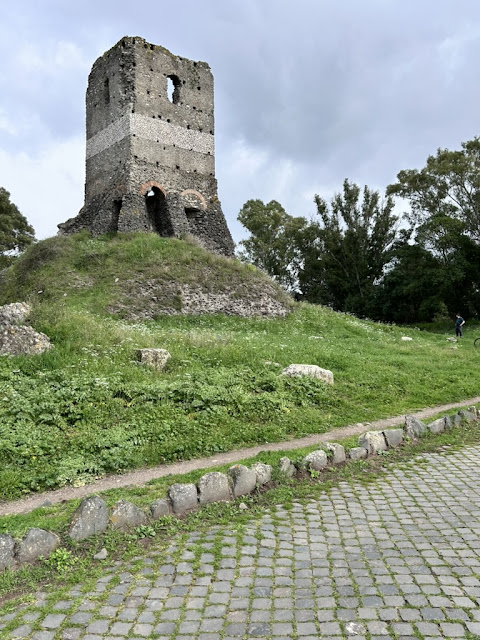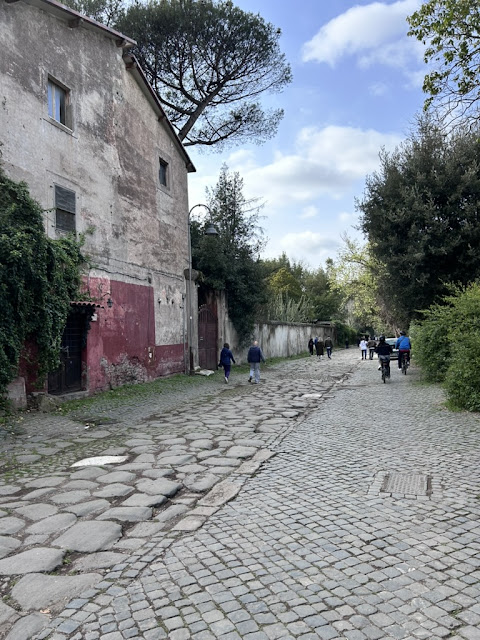Feelings of Today: You can read about a thing, but you cannot learn it as well without experiencing it. You can read about martial arts, but do you know how to use it? You’ve read the rules of a game, but do you know the nuances of playing it well? You’ve read about Roman roads and seen pictures of them, but have you ever traveled down one?
Full Day’s Events: So, I like history, if you haven’t been able to tell in my emails so far. Today was a day of physically interactive, yet bumpy, history. Natalie and I were going to mountain bike down the Appian Way. What is the Appian Way, you say? Well hooray! This info I now convey.
The Roman Republic needed a better way to “incorporate” its Southern neighbours into its control. Sponsoring colonists and sending military “visitors” started the second Samnite war. Since the route was long the colonists and military “visitors” needed supplies of all kinds. The capital, Rome, also needed fast updates on progress made so they funded a straight-ish and solid Roman road, of the type that had been made in several places before. The Appian Way was named after the Consol who started it (Appius Claudius Caecus) and a part of it was started and finished in 312 BCE. After the second Samnite war ended, more sections were added until the Appia Longarum - regina viarum (Appian Way - Queen of the Roads) went to Brindisi at the heel of Italy and took 48 years. The Appian Way was very important in subjugating the South of Italy and setting up Brindisi as a Naval port for military expansion Eastwards. Today, a Sunday, is the best day to bike down it because only locals can drive it!
We visited the Church of Domaine de Quo Valdis, the place where it is said Jesus appeared to Peter when he was trying to escape death in Rome and turned back. At Centro Service - Appia Antica EcoBike, for 20 euros you can rent a bike with helmet and lock from 9am until 5pm, and they give you a map of the sites you will see.
Our first stop, to the side of the Appian, was a crypt where over twenty kilometres of tunnels, with five levels, once contained nearly half a million bodies. The Catacombs of Callixtus was established during the 2nd CE. Christians were heavily persecuted at this time, but since all dead bodies had to be placed outside of city limits the site was authorized by Rome. The soft volcanic stone was easily dug through and places for individuals, families, and martyrs were adding to the initial tunnels. When Christianity was legal, in 313CE under the Edict of Milan, worshippers were able to bury their dead in the ground on the surface. After the Roman Empire fell, and barbarian hordes invaded, the crypts were looted and damaged. They were then closed up, forgotten about, and rediscovered by Giovanni Batista de Rossi who found many of the crypts around Rome.
Although the tour was short, at about 45 minutes, it was very interesting. The openings for the bodies, which would have been sealed with brick or other substances, could have up to seven spaces stacked on top of one another. The labyrinth of tunnels had markers to guide people, to dead family or friends, and had places to put candle lamps to guide you in and back. It was quite cool but had a constant temperature. There were also air shafts so people could breathe. The volcanic rock was slightly acidic so bodies broke down easily leaving the bones behind. Some family areas were nicely painted and we saw nicer areas where past popes were buried. No photos were permitted so you will have to consult this link for what it looked like.
Leaving the crypt, on the smooth paved road, we entered the square stone road of the Appian Way. We were permitted to bike on it except when the road was rough or larger stones were placed in the big holes to allow road traffic to transit it. Sometimes it was smooth and sometimes very jarring. During most of the rough parts there was a dirt path on the side of the road, so there were options for people. I tried to stay on the road as much as possible and found going at a slow run was best.
We got to the Estate of Emperor Maxentius and it contained a Circus, Mausoleum, was free to enter, and they had a bunch of Roman era reenactors on site! Soldiers, officers, a noble woman, archer, and performers were doing drills, speaking to visitors, marching, or teaching young children how to be a Roman Legionnaire. The site itself was quite fun to walk around, but we had to get moving.
Continuing our trek we stopped, examined items, and took pictures of various tombs, monuments, and markers that Romans had built to make themselves remembered. We decided caloric sustenance was required so we stopped at the Appian Antica cafe, each procuring a shared salad (arugula, tomatoes, and bocconcini cheese) and a panini sandwich each. I picked a grilled zucchini and ham while her’s was chicory and goat cheese.
Reapplying sunscreen, in the 20-degree Celsius heat, we continued down the Appian for a total of 11-12 km. The road was variable in its condition and we saw on each side crumbled or intact monuments, tombs, villas for weddings, towers statues, and one more mausoleum with a farmhouse on top. There were also brilliant flowers, tall trees with broad canopies, and country cats lingering on the hot Roman structures.
We had planned to visit some aqueducts to the North East of the Appian, but time was not on our side. Now to bike back.
On the way back, we made a short stop at the Mausoleum of Cecilia Matella. In the first century BCE she was the daughter in law to the richest person in Rome, Quintus Caecilius Metellus Creticus, who was also a consol. She was also married to Marcus Licinius Crassus (who served with Caesar in the army and had a father and son by the same name) so when she died her son built this structure. Over time it became a fortified manor and is now a little museum. A cat set up a permanent snoozing spot on the stairs going into the structure, such that you had to move around it. It didn’t move during the 20 minutes we were exploring the structure. No, it was not a dead cat, just breathing deeply and slowly.
Two more pictures on the way to the Bike place.
Bike returned, we went back to our place. Showering and getting dressed we walked to Il Corallo, to eat at one of the recommended places. My wife had lightly fried chicory balls with cheese sauce and I had the tomato and basil salad with a large burrata buffalo cheese ball in the middle. When I cut through the cheese it slowly oozed out and was delicious. She tried the daily pasta, gnocchi made with squash and a Gorgonzola cheese sauce. I had spaghetti with sweet fresh clams and mini squids and sun-dried tomatoes. Yum yum! She couldn’t finish her Gnocchi so we split it the next night.
Walking home, at night, we took little side streets and ended our day. 22-24 km biked, 7.7 km walked, and 24 flights of stairs climbed.



















































No comments:
Post a Comment